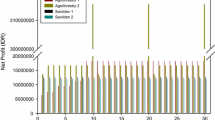Abstract
The Khasia ethnic community of Bangladesh has been a population of forest villagers in the north-eastern hill forests of Bangladesh since the early 1950s, practicing a betel leaf-based agroforestry system on land granted by the Forest Department. Taking a sample forest village of the Sylhet forest division as a case study, this article examines the sustainability attributes of betel leaf production in the agroforestry system. The presence of several positive attributes of sustainability including the composition of agroforestry, disease control, soil fertility management, profitability, socio-cultural acceptability and institutional support indicate that betel leaf production within the agroforestry system is stable under the prevailing traditional management system. Income from the sale of betel leaf is the principal livelihood means and villager’s reciprocal contributions help to conserve forest resources. However, problems with land ownership and regular agreement renewal need to be resolved for the sake of their livelihoods and forest conservation.

Similar content being viewed by others
Notes
Yin (2003) also suggested selecting one representative case study site if there are no remarkable differences among sites.
Even though all households supposedly have only one agroforestry plot in this village, six households were found to have more than one agroforestry plot. Villagers said that some of them have expanded their holdings illegally, some purchased from others, and some inherited land from their kin (Gousti or extended patrilineal family members).
References
Agrawal A, Gupta K (2005) Decentralization and participation: the governance of common pool resources in Nepal’s Terai. World Dev 33:1101–1114. doi:10.1016/j.worlddev.2005.04.009
Alam MK, Mohiuddin M (1995) Conservation of tree diversity through betel-leaf (Piper betel) based agroforestry in Sylhet. Bangladesh J For Sci 24(2):49–53
Alam MK, Ahmed FU, Mohiuddin M (1993) Agroforestry practices in forest land. In: Chowdhury MK, Tej BM (eds) Agroforestry-farming systems linkages in Bangladesh. BARC-Winrock International Agroforestry and participatory Forestry Research and Training Support Program, Dhaka, Bangladesh, pp 87–122
Alhamidi SK, Gustafsson M, Larsson H, Hillbur P (2003) The cultural background of the sustainability in the Ghouta, the oasis of Damascus, Syria. Agric Human Values 20(3):231–240. doi:10.1023/A:1026123929170
Forest Department (1970) Working plan for the forests of the Sylhet division for the period 1963–64 to 1982–83, vol I. East Pakistan Government Press, Dacca
Banglapedia (Encyclopaedia of Bangladesh) (2001) BANGLAPEDIA: Khasia. http://banglapedia.search.com.bd/HT/K_0215.htm. Accessed 10 Feb 2007
Das LNCSC (1999) Srimangal Dharmapallir Itikatha (in Bengali). Luxmibazar, Suprakash Printers, Dhaka
Dumanski J, Terry E, Byerlee D, Pieri C (1998) Performance indicators for sustainable agriculture. Discussion note, rural development sector. The World Bank, Washington, DC
Franzel S, Denning GL, Lilleso JPB, Mercado AR Jr (2004) Scaling up the impact of agroforestry: lessons from three sites in Africa and Asia. Agrofor Syst 61(1–3):329–344. doi:10.1023/B:AGFO.0000029008.71743.2d
Guha P (2006) Betel leaf: the neglected green gold of India. J Hum Ecol 19(2):87–93
ITTO (International Tropical Timber Organization) (2005) Revised ITTO criteria and indicators for the sustainable management of tropical forests including reporting format, ITTO Policy Development Series No. 15, Yokohama, Japan
Komatsu Y, Tsunekawa A, Ju H (2005) Evaluation of agricultural sustainability based on human carrying capacity in dry lands—a case study in rural villages in Inner Mongolia, China. Agric Ecosyst Environ 108(1):29–43. doi:10.1016/j.agee.2004.12.017
Lamberton G (2005) Sustainable sufficiency—an internally consistent version of sustainability. Sustain Dev 13(1):53–68. doi:10.1002/sd.245
McNeely JA (2004) Nature vs. nurture: managing relationships between forests, agroforestry and wild biodiversity. Agrofor Syst 61–62(1–3):155–165. doi:10.1023/B:AGFO.0000028996.92553.ea
Nair PKR (1993) An introduction to agroforestry. Kluwer Academic Publishers, The Hague
Nath TK, Inoue M, Islam MJ, Kabir MA (2003) The Khasia tribe of northeastern Bangladesh: their socio-economic status, hill farming practices and impacts on forest conservation. For Trees Livelihoods 13(4):297–311
Nath TK, Inoue M (2008) Forest villagers in northeastern hill forests of Bangladesh: linkages between villager’s livelihood and forest conservation. In: Watkins MM (ed) World poverty issues. Nova Science Publishers Inc, NY, pp 37–67
Rashid HR (1991) Geography of Bangladesh. University Press Ltd, Dhaka
Rasul G, Thapa GB (2004) Sustainability of ecological and conventional agricultural systems in Bangladesh: an assessment based on environmental, economic and social perspectives. Agric Syst 79(3):327–351. doi:10.1016/S0308-521X(03)00090-8
Riadh SM (2007) Assessing the role of non-timber forest products in the livelihoods of communities living inside and outside of Lawachara national park. In: Fox J, Bushley BR, Dutt S, Quazi SA (eds) Making conservation work: linking rural livelihoods and protected area management in Bangladesh. East-West Center and Nishorgo program of the Bangladesh Forest Department, pp 36–49. http://scholarspace.manoa.hawaii.edu/bitstream/10125/3401/1/making-conservation-work.pdf. Accessed 07 Jan 2009
Roy RD (1998) Land rights, land use and indigenous peoples of the Chittagong hill tracts. In: Gain P (ed) Bangladesh- land, forest and forest people, 2nd edn. Society for Environment and Human Development (SEHD), Dhaka, pp 53–118
Saha N, Azam MA (2004) The indigenous hill-farming system of Khasia tribes in Moulvibazar district of Bangladesh: status and impacts, small-scale forest economics. Manage Policy 3(2):273–281
Saha N, Azam MA (2005) Betel leaf based forest farming by Khasia tribes: a sustainable system of forest management in Moulvibazar district, Bangladesh. For Trees Livelihoods 15(3):275–290
Statistical Year Book Bangladesh (2007) Statistical Year Book Bangladesh-2007. Online www.bbs.gov.bd/dataindex/pb_wb_page.pdf. Accessed 02 Oct 2008
Walker A (2004) Seeing farmers for the trees: community forestry and the arborealisation of agriculture in northern Thailand. Asia Pac Viewp 45(3):311–324. doi:10.1111/j.1467-8373.2004.00250.x
Yin RK (2003) Case study research design and methods, Applied social research methods series, vol 5, 3rd edn. SAGE Publications, London and New Delhi
Zhen L, Routray JK, Zoebisch MA, Chen G, Xie G, Cheng S (2005) Three dimensions of sustainability of farming practices in the North China Plain—a case study from Ningjin County of Shandong province, PR China. Agric Ecosyst Environ 105(3):507–522. doi:10.1016/j.agee.2004.07.012
Author information
Authors and Affiliations
Corresponding author
Rights and permissions
About this article
Cite this article
Nath, T.K., Inoue, M. Sustainability Attributes of a Small-Scale Betel Leaf Agroforestry System: A Case Study in North-eastern Hill Forests of Bangladesh. Small-scale Forestry 8, 289–304 (2009). https://doi.org/10.1007/s11842-009-9084-4
Received:
Accepted:
Published:
Issue Date:
DOI: https://doi.org/10.1007/s11842-009-9084-4




